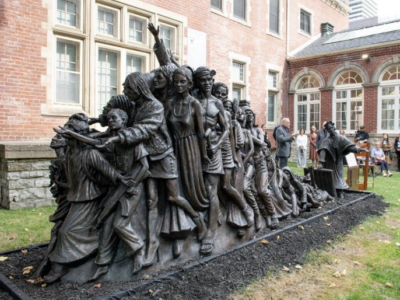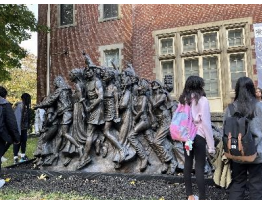Tina Drakeford is a PhD candidate in her fourth year at the Regis St. Michael’s Faculty of Theology. Her areas of interest are ecclesiology and Catholic education, and particularly how we might understand Catholic schools in Ontario as expressions of Church. Since 2006, Tina has also been blessed to serve in Catholic education as an elementary teacher, a special education teacher, and on board-level committees throughout her time in the public Catholic school system.
Sonal Castelino, xmcj is the Director of Campus Ministry at the University of St. Michael’s College.
On October 5th people gathered on the lawn of Christie Mansion to witness the unveiling of the white tent that mysteriously appeared in August.
As the cloth was removed the gathered saw the sculpture that is, at first, overwhelming, of multiple figures surging upwards from underground and a woman holding open a trap door. As we look closer, details begin to emerge: the figures take the form of almost 100 different individuals that are personified stories of human trafficking. There are figures of all ages from a newborn baby to child soldiers, forced beggars, migrant workers, and people who look just like you or me. The sculpture hosted by Regis College that sits on the Christie Mansion lawn is a replica of the original one that stands in the Vatican and was blessed by Pope Francis this past February. On that sunny October morning at the unveiling, artist Tim Schmalz spoke to those gathered and shared his inspiration for this work. The woman is St. Josephine Bakhita who, in the artist’s words, is an “African saint who was in a previous century a slave, opening up the underground to let modern-day slaves go free.”
The artist had previously created a sculpture, Angels Unawares, inspired by the refugee experience that was also installed in St. Peter’s Square by Pope Francis. So moving was this first piece that the Vatican requested a second piece addressing the issue of human trafficking. Let The Oppressed Go Free is the answer to that request. Schmalz describes this work as exploring the “horrifying scope” of human trafficking, something that is often invisible, affecting all nationalities and people from all circumstances in life. In particular, Schmalz highlighted that he included victims designed to appear “normal” to dispel the stereotype that the victims of human trafficking are always easily identifiable.

Another major inspiration for the final form of this work comes from words spoken by Pope Francis: “Human trafficking will always exist as long as it remains underground.” Let the Oppressed Go Free is a visual representation of the survivors of human trafficking literally being released from underground. But beyond this visual representation, we must move forward and ensure that the reality of human trafficking isn’t buried in whispered conversations but rather is spoken of boldly so that, equipped with knowledge, we can work for change and move towards justice.
One of the ways this sculpture is helping to do that is through a school program that saw about 200 students from grades 7 through 10 visit the Regis and St. Michael’s campuses on October 24th. These students hailed from three schools in the Dufferin-Peel District School Board, including St. Josephine Bakhita Elementary School. The school program is being coordinated by representatives from St. Michael’s Campus Ministry and the Regis St. Michael’s Faculty of Theology. Both the elementary and secondary students had the opportunity to visit the sculpture, hear Schmalz speak about his work, and to learn about human trafficking. The secondary school students also participated in a migrant worker activity led by the Social Justice and Care for Creation ministries of the Sisters of St. Joseph that highlights human exploitation through the temporary foreign worker program in Canada, while the elementary students engaged in an art-based activity designed to deepen their understanding of agency and choice in grade-appropriate ways, facilitated by the Centre for Jesuits International.

In addition to the learning activities around human trafficking, students also had the opportunity to visit various stations throughout campus and explore pieces of art ranging from Schmalz’s other works, Homeless Jesus and the Dante Gardens, and the St. John’s Bible. Throughout the day, students were invited to consider ways they can make an impact in the world around them, and how God is calling each of us to work for justice for those who are oppressed.
Let the Oppressed Go Free is presently on loan here on the Christie Mansion lawn. We invite you to take some time to visit, to reflect, and to consider how we bring the issue of trafficking up from the underground and continue the work to let the oppressed go free.
Read other InsightOut posts
